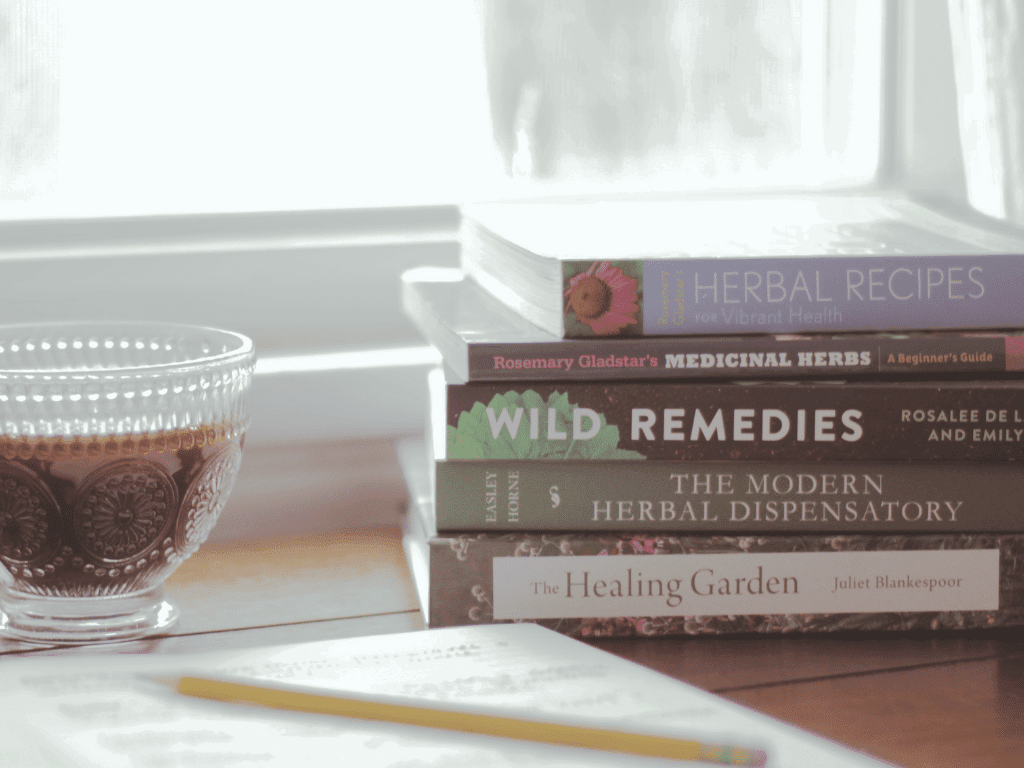Introduction
Hello and welcome! In the following weeks, I will be posting from my personal materia medica for some of my favorite herbs. For those who don’t know, a materia medica is a collection of your knowledge written in a journal, notebook, binder, index cards, etc. Herbalists build their collection over time as they study and use each herb. Today I am discussing spilanthes, also called buzz buttons, electric daisy, or toothache plant.
Spilanthes (Acmella oleracea) is part of the daisy family (Asteraceae). It lives up to the name electric daisy because one tiny nibble on a fresh flower will quickly cause a buzzing, numbing sensation in your mouth, followed by an increase in saliva production. I made the mistake of taking a not-so-small bite and instantly regretted it! The taste is pungent, and the numbing effects are strong. Dried flowers have less potency, but they still pack quite a punch.
Identification
[1, 4]
Spilanthes is an herbaceous perennial growing to about a foot in height and one to two feet in width. It has erect stems and ovate, toothed leaves, which come together to form a sharp tip at the end [4]. The flower heads are elongated and often have a red-tipped center, though some are all yellow.
History & Folklore
[1, 4]
Formerly called Spilanthes acmella, Acmella oleracea is native to Brazil and is now cultivated around the world. For centuries, it has been used for medicine and food in many traditions. Spilanthes has also gained popularity as a cocktail garnish for its interesting electric effect on the mouth. An extract of the oil, called Jambu oil or Jambu extract (not to be confused with the Jambu apple tree), is used as medicine or to flavor foods and chewing gum.

Medicinal Uses
[1, 2, 3, 5, 7, 8]
Spilanthes is often used for strengthening teeth and gums. The tincture or infusion can be used as a mouthwash, and the dried aerial parts can be ground into a powder for tooth powder. Its numbing actions can help alleviate the pain from bug bites, stings, and dental/mouth pain. However, my favorite way to use spilanthes is as an immune stimulant during cold and flu season. As with any immune stimulant, it should be used for only a short time.
Join Our Newsletter
Sign up for our monthly newsletter to get easy gardening tips, seasonal to-dos, and herbal recipes delivered right to your inbox.
Thank you!
Check your email to confirm your subscription.
Spilanthes has antimicrobial actions and can be used to help with several types of infections, such as UTIs, skin issues, ear infections, or sinus infections. It stimulates mucous membrane secretions to help strengthen the respiratory system. *Remember to seek medical treatment for infections from your doctor or a licensed medical professional.*
Warnings: Spilanthes should not be taken for long periods of time, and it may not be safe for those with autoimmune conditions. It may cause allergic reactions in those with allergies to plants in the daisy family (Asteraceae). Numbing effects can be strong so be cautious of large doses. It many not be safe for those taking diuretics.
Growing Spilanthes
[1, 4]
Acmella oleracea prefers rich, well-draining soil and full to partial sun. Spilanthes is a frost-sensitive perennial, but in my zone 5 climate, I grow it as an annual. Spilanthes grows to only about a foot high, so I put them in the front of my beds with taller plants, like calendula, behind it. They are easy to grow and don’t require too much attention. Make your garden inviting to frogs and ladybugs because the slugs and aphids love spilanthes. The flowers also attract fireflies, so at night watch for the beautiful light show.
I prefer making tinctures out of fresh plant material because the medicine reduces potency as the plant dries. Because of this, I wait until the plant is large enough to harvest a big batch. It will grow back for another harvest or two before fall. Two plants will provide plenty of medicine for one family.

Spilanthes Properties
[1, 2, 3, 5, 7, 8]
Common Name: Spilanthes, Buzz Buttons, Electric Daisy, Toothache Plant
Scientific Name: Acmella oleracea (formerly Spilanthes acmella)
Family: Daisy, Asteraceae
Parts Used: Flowers and leaves
Energetics: Mildly Warming, Mildly Drying, Stimulating, Dispersing
Constituents: Spilanthol, Acmellonate
Actions: Analgesic/Anodyne, Antimicrobial, Astringent, Diuretic, Immune Stimulant, Sialagogue (stimulates saliva production)
Organ Systems: Lymphatic, Integumentary
Preparations: Tincture, tea, poultice, tooth powder

Preparations
[1, 3]
Infusion: 1 – 2 tsp. (dried or fresh aerial parts) per 8 oz water up to up to 3x per day
Tincture: Fresh (1:2 95%) 2 – 4 mL 3 times a day
Fresh herb for toothache or mouth pain: Chew the flower heads and/or leaves for pain relief. Test a small amount first!
References
1. Blankespoor J. The Healing Garden. Mariner Books; 2022.
2. Dubey S, Maity S, Singh M, Saraf SA, Saha S. Phytochemistry, Pharmacology and Toxicology of Spilanthes acmella: A Review. Advances in Pharmacological and Pharmaceutical Sciences. 2013;2013:e423750. doi:10.1155/2013/423750
3. Easley T, Horne S. The Modern Herbal Dispensatory: A Medicicne-Making Guide. North Atlantic Books; 2016.
4. Mountain Rose Herbs. Spilanthes. Mountain Rose Herbs. https://mountainroseherbs.com/spilanthes
5. Paulraj J, Govindarajan R, Palpu P. The Genus Spilanthes Ethnopharmacology, Phytochemistry, and Pharmacological Properties: A Review. Adv Pharmacol Sci. 2013;2013:510298. doi:10.1155/2013/510298
6. Ramachandran RG, Radhakrishnan R. Anatomical Characterization of Nine Taxa of Genus Acmella Rich. (Toothache Plant) in India. Braz arch biol technol. 2020;63:e20190083. doi:10.1590/1678-4324-2020190083
7. Sharma R, Arumugam N. N-alkylamides of Spilanthes (syn: Acmella): Structure, purification, characterization, biological activities and applications – a review. Future Foods. 2021;3:100022. doi:10.1016/j.fufo.2021.100022
8. Spilanthes acmella | Memorial Sloan Kettering Cancer Center. https://www.mskcc.org/cancer-care/integrative-medicine/herbs/spilanthes-acmella-jambu












